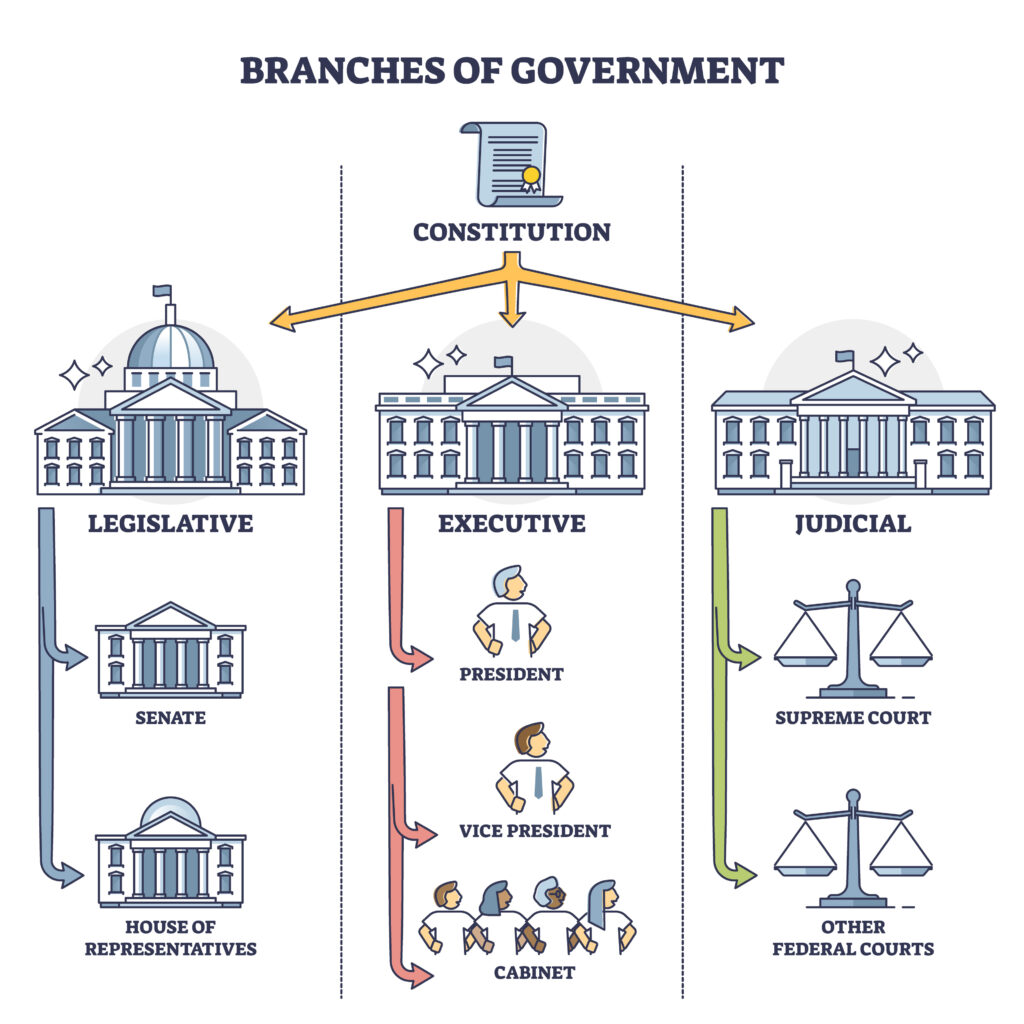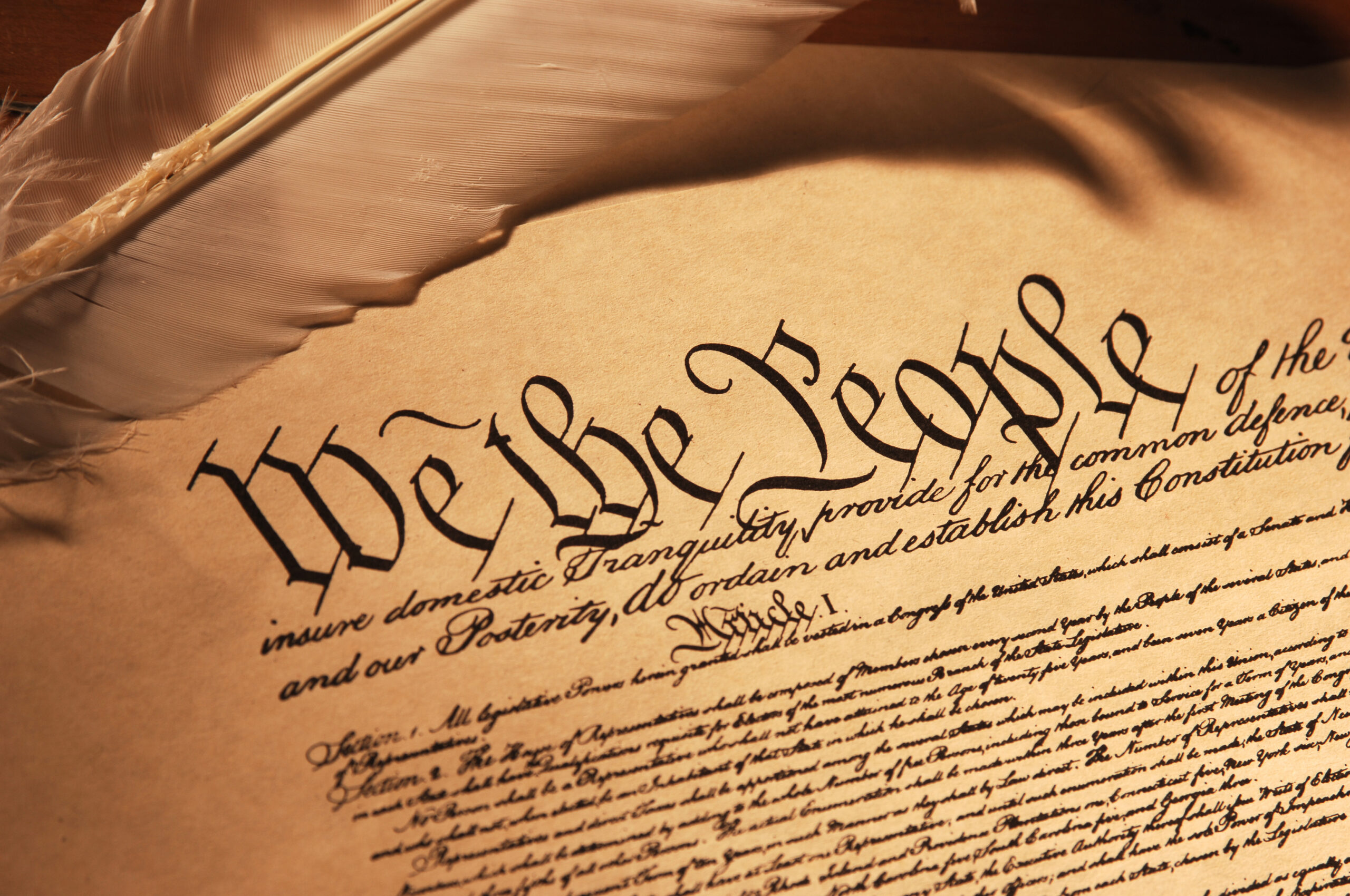The Constitution is the foundation of the U.S. government. It balances power between the three branches, protects individual rights, and can be changed when necessary. It ensures democracy, where power comes from the people, and guarantees fairness, freedom, and justice for all Americans
Preamble: “We, the people of the United States, want to create a fair and just government, ensure peace within our country, provide protection, support the well-being of everyone, and secure freedom for ourselves and future generations. To accomplish this, we establish this Constitution.”
The Preamble sets the purpose of the Constitution. It declares that power comes from the people and that the government exists to serve them. It emphasizes fairness, peace, security, and prosperity, ensuring that the rights and freedoms established in the Constitution benefit both current and future generations. It serves as a guiding principle for the rest of the document, shaping how laws and policies should reflect these core values.
The Importance of Knowing the Constitution Understanding the Constitution is crucial because it defines the rights and freedoms of all Americans. It ensures that people know their protections under the law and can recognize when their rights are being violated. Knowing the Constitution empowers individuals to hold the government accountable, participate effectively in democracy, and advocate for changes when necessary. For African Americans and other marginalized communities, knowledge of the Constitution has historically been key to fighting discrimination and securing equal rights. By understanding its principles and amendments, citizens can work toward a more just and equitable society.
Implications for African Americans: Although the Constitution initially did not protect African Americans’ rights, amendments and laws over time have changed that. The 13th Amendment abolished slavery, but racism and discrimination persisted through segregation and unequal treatment under the law. The 14th Amendment guaranteed citizenship and equal protection, yet systemic discrimination continued. The 15th Amendment granted Black men voting rights, but Jim Crow laws and voter suppression limited access to the ballot for decades.
The Civil Rights Movement led to stronger enforcement of these rights, with the Voting Rights Act of 1965 ensuring better protections. Despite these advances, issues like racial profiling, economic disparities, and voter suppression remain challenges. Understanding the Constitution helps African Americans advocate for justice, equality, and civil rights, ensuring the government remains accountable to all its people.
The U.S. Constitution: The Three Co-Equal Branches of Government, Articles 1, 2, and 3, The Bill of Rights, and Other Important Amendments
The U.S. Constitution establishes the three co-equal branches of government—Legislative, Executive, and Judicial—in the first three articles:

- Article I – The Legislative Branch
- Establishes Congress, which consists of the Senate and House of Representatives.
- Grants Congress the power to make laws, levy taxes, regulate commerce, declare war, and more.
- Article II – The Executive Branch
- Establishes the office of the President and Vice President.
- Defines the powers and responsibilities of the President, including enforcing laws, serving as Commander-in-Chief, making treaties (with Senate approval), and appointing federal officials.
- Article III – The Judicial Branch
- Establishes the Supreme Court and allows Congress to create lower federal courts.
- Grants the judiciary the power to interpret laws and review their constitutionality (judicial review was later solidified in Marbury v. Madison in 1803).
These three articles ensure the separation of powers and a system of checks and balances, preventing any one branch from becoming too powerful
Article 1 – The Legislative Branch This article establishes the legislative branch of government, called Congress, which is responsible for making laws. Congress is divided into two chambers: the House of Representatives and the Senate.
Article 1 is the longest and most detailed section of the Constitution, reflecting the importance of the legislative branch in a democratic government. By dividing Congress into two chambers with different responsibilities and structures, it ensures a balance between representing the population and protecting the interests of states. The process of passing laws is designed to be thorough, requiring debate, approval from both chambers, and the President’s signature. Additionally, Congress is granted powers necessary to govern effectively while also being subject to checks and balances to prevent abuse of power. This structure helps maintain a stable government that reflects the will of the people while preventing any single entity from becoming too powerful.
Responsibilities of the Legislative Branch:
Congress refers to the entire legislative branch of the United States government, which is made up of two chambers: the Senate and the House of Representatives. The legislative branch is responsible for creating and maintaining the legal framework of the country.
Key Differences:
- Size & Representation: The Senate has 100 members (two from each state serving six-year terms), while the House of Representatives has 435 members, with representation based on population. Representatives serve two-year terms.
- Debate: The Senate allows more extended debate and fewer restrictions on speaking time, whereas the House has more structured debates.
In short, while both chambers of Congress share in the lawmaking process, the Senate has specific duties regarding confirmations, treaties, and impeachment that set it apart from the House of Representatives.
The main responsibilities of Congress as a whole include:
- Congress collect taxes, regulate trade, create money, declare war, and make any laws necessary to carry out its duties.
- Laws must pass both the House and the Senate before the President signs them into effect.
- Congress has the authority to impeach and remove government officials, including the President, if they commit serious misconduct.
- Pass federal laws that affect the entire country.
- Approve the national budget and determine government spending.
- Declare war and manage national defense.
- Regulate trade and commerce, both within the U.S. and internationally.
- Oversee the executive branch through investigations and hearings.
- Approve treaties and presidential appointments, such as judges and cabinet members.
- Initiate the impeachment process for government officials accused of misconduct.
The House of Representatives “Congress”
- Making Laws: Congress has the primary responsibility for creating and passing laws.
- Appropriating Funds: Congress determines government spending and the budget, including approval of federal funds.
- Oversight: Congress monitors and oversees the executive branch to ensure that laws are being implemented properly.
- Constituent Services: Members of Congress represent the interests of their constituents, addressing issues that affect their home states or districts.
The Senate
The Senate has specific responsibilities distinct from the House of Representatives:
Confirming Appointments: The Senate confirms presidential appointments, such as federal judges, Cabinet members, and ambassadors.
- Ratifying Treaties: The Senate must approve international treaties negotiated by the President by a two-thirds majority vote.
- Impeachment Trials: The Senate conducts impeachment trials for federal officials, including the President. While the House can impeach (accuse) an official, the Senate holds the trial and votes on whether to remove the official from office.
- Legislation: Senators participate in crafting and voting on legislation, though the Senate typically focuses on broader, national issues.
Article 2 – The Executive Branch This part creates the presidency. The Executive Branch of the U.S. government consists of several key components that work together to enforce laws and govern the country.Article 2 defines the powers and responsibilities of the President. It ensures a balance of power by giving the President authority while also placing limits—such as requiring Senate approval for treaties and allowing Congress to override vetoes. This system prevents any one branch from becoming too powerful.
1. The President The President is elected every four years and must be a natural-born citizen at least 35 years old.
- Head of State and Government – Represents the nation and leads the executive branch. Enforces federal laws and manages the government.
- Commander-in-Chief – The President is the leader of the military.
- Chief Diplomat – Negotiates treaties and conducts foreign relations.
- Legislative Role – Signs or vetoes bills passed by Congress.
- The President appoints government officials, including Supreme Court judges.
2. The Vice President
- Presides over the Senate – Casts tie-breaking votes when needed.
- Assists the President – Takes on special assignments as directed.
- Presidential Succession – Becomes President if the sitting President can no longer serve.
3. The Executive Office of the President (EOP)This includes advisory and support agencies that help the President with decision-making and policy implementation. Key offices include:
4. The Cabinet The Cabinet consists of 15 executive departments, each headed by a secretary (except for the Attorney General). These departments enforce laws and manage federal programs:
- Department of State – Handles foreign relations.
- Department of the Treasury – Manages finances and taxation.
- Department of Defense – Oversees the military.
- Department of Justice – Enforces laws and oversees legal affairs (led by the Attorney General).
- Department of the Interior – Manages public lands and natural resources.
- Department of Agriculture – Oversees farming and food safety.
- Department of Commerce – Regulates trade and economic development.
- Department of Labor – Protects workers’ rights and employment regulations.
- Department of Health and Human Services – Manages healthcare programs like Medicare and Medicaid.
- Department of Housing and Urban Development (HUD) – Oversees housing policies.
- Department of Transportation – Manages highways, air travel, and transportation safety.
- Department of Energy – Handles energy policies and nuclear security.
- Department of Education – Oversees national education policies.
- Department of Veterans Affairs – Provides services for military veterans.
- Department of Homeland Security – Handles national security and emergency response.
5. Independent Agencies and Commissions These agencies operate independently from the Cabinet but are still part of the executive branch. Examples include:
- Central Intelligence Agency (CIA) – Handles intelligence and national security.
- Federal Bureau of Investigation (FBI) – Investigates federal crimes.
- Environmental Protection Agency (EPA) – Regulates environmental policies.
- Federal Communications Commission (FCC) – Oversees communications regulations.
- National Aeronautics and Space Administration (NASA) – Handles space exploration.
6. The U.S. Military While the military is not a civilian agency, it falls under the executive branch, with the President as Commander-in-Chief.
The Department of Defense (DOD) oversees the Army, Navy, Air Force, Marine Corps, Space Force, and Coast Guard (during wartime).
Article 3 – The Judicial Branch This part creates the Supreme Court and other federal courts to interpret laws.
Article 3 establishes the judiciary as an independent branch, ensuring fair interpretation of the law. By granting judges lifetime appointments, it protects them from political influence. The courts play a crucial role in checking the power of Congress and the President by ruling on whether laws and actions are constitutional.
- Judges serve for life unless they retire or are removed for misconduct.
- The courts ensure laws follow the Constitution and settle disputes between states.
Article 4 – States’ Rights and Responsibilities This part explains how states interact with each other and the federal government.
Article 4 promotes unity by ensuring that states recognize each other’s legal decisions, such as marriages and contracts. It also allows for the expansion of the country by admitting new states and guarantees that the federal government will defend states from threats.
- States must respect each other’s laws and court decisions.
- New states can be admitted by Congress.
- The federal government must protect states from invasion.
Article 5 – How to Amend the Constitution This part explains how changes (amendments) can be made.
Article 5 ensures that the Constitution can adapt over time. The amendment process is deliberately challenging to prevent frequent or unnecessary changes, but it allows for necessary updates, such as those that expanded civil rights and voting rights. This process ensures that laws reflect the evolving values of society while maintaining stability.
- Amendments must be proposed by two-thirds of Congress or a national convention.
- They must be approved by three-fourths of the states.
Article 6 – The Supremacy of the Constitution This part states that the Constitution is the highest law of the land.
Article 6 establishes that the Constitution, along with federal laws and treaties, takes precedence over state laws. This means that if a state law contradicts a federal law, the federal law must be followed. It also ensures that government officials, including state and federal lawmakers, judges, and executives, must pledge their loyalty to the Constitution. This article helps maintain unity by preventing states from acting independently in ways that could undermine national law.
- All government officials must swear to uphold the Constitution.
- Federal laws override state laws if they conflict.
Article 7 – Ratification This part explains that the Constitution became official when nine of the thirteen original states approved it.
The Bill of Rights (First 10 Amendments)
- Freedom of speech, religion, press, assembly, and petition – People can express themselves and protest without fear: This amendment protects personal freedoms, allowing individuals to speak freely, practice any religion, publish their views, gather in groups, and challenge the government. However, these rights have limits, such as restrictions on speech that incites violence.
- Right to bear arms – People can own weapons for self-defense: Originally intended for militias, this amendment has been interpreted as allowing private citizens to own firearms, but with regulations and restrictions in place.
- No forced housing of soldiers – The government can’t make people house soldiers in peacetime: This amendment prevents the government from forcing people to house troops, a reaction to British practices before the Revolutionary War.
- No unreasonable searches or seizures – Police need a warrant to search property: Authorities cannot search or take property without legal permission or probable cause, ensuring privacy and protection from government abuse.
- Right to remain silent and fair trials – People can’t be forced to confess and have the right to due process: This amendment protects individuals from self-incrimination, double jeopardy (being tried twice for the same crime), and ensures fair treatment in legal proceedings.
- Right to a speedy trial and lawyer – People accused of crimes must get a fair trial with a lawyer: Ensures that accused individuals have a prompt trial, legal representation, and the opportunity to confront witnesses against them.
- Right to a trial by jury in civil cases – Non-criminal disputes can be decided by a jury: Provides individuals with the right to have legal disputes settled by a jury, ensuring fairness in civil cases.
- No cruel and unusual punishment – Punishments must be fair: Prevents excessive fines, harsh penalties, and inhumane treatment, though debates continue over what constitutes “cruel and unusual.”
- Other rights exist – Just because a right isn’t listed doesn’t mean people don’t have it: Protects unenumerated rights, meaning people have additional rights beyond those explicitly mentioned in the Constitution.
- States’ rights – Powers not given to the federal government belong to the states or the people: Limits federal power by ensuring states and individuals retain authority over areas not addressed by the Constitution.
Other Important Amendments
- 13th Amendment – Ended slavery: The 13th Amendment abolished slavery and involuntary servitude, except as punishment for a crime. While it officially ended slavery in 1865, forced labor practices and racial discrimination continued in different forms, such as the convict leasing system and segregation laws. It was a crucial step toward freedom for African Americans, but systemic racism remained a significant barrier.
- 14th Amendment – Gave citizenship to all born in the U.S. and ensured equal protection under the law. The 14th Amendment granted citizenship to all people born or naturalized in the U.S., including formerly enslaved individuals. It also guaranteed equal protection under the law, which meant that states could not discriminate against citizens. However, despite this amendment, African Americans faced continued segregation and discrimination, leading to landmark civil rights battles to enforce these rights.
- 15th Amendment – Gave Black men the right to vote: The 15th Amendment declared that the right to vote could not be denied based on race, color, or previous condition of servitude. While it was a major victory for African Americans, many states imposed poll taxes, literacy tests, and other discriminatory practices to suppress Black voting rights, which were not fully protected until the Voting Rights Act of 1965.
- 19th Amendment – Gave women the right to vote.
- 22nd Amendment – Limited the President to two terms.
- 26th Amendment – Lowered the voting age to 18.


































